Overview
Choosing native iOS apps for development success is not just a preference; it's a strategic advantage. Developers often face challenges in performance and user experience. How can these be effectively addressed? Native apps stand out due to their superior performance, user experience, and seamless integration with Apple services. This is evident in the way native apps utilize system resources more effectively, adhere to design guidelines for improved usability, and provide robust security and monetization opportunities. These factors collectively enhance overall app quality and user satisfaction. By opting for native development, developers can significantly improve productivity and deliver a more satisfying user experience.
Introduction
In the competitive realm of mobile app development, developers often encounter significant challenges that can hinder their progress. However, native iOS applications have emerged as a powerful solution, combining performance, user experience, and security to create exceptional products. With tools like Kodezi streamlining the development process, developers can focus on crafting apps that are not only efficient but also deeply integrated with Apple’s ecosystem.
How can Kodezi help you overcome coding obstacles? By offering features designed to enhance productivity and code quality, Kodezi empowers developers to navigate the complexities of app development with ease. This article delves into the myriad advantages of native iOS app development, from leveraging hardware capabilities to ensuring robust security measures. Furthermore, adhering to Apple's guidelines is crucial for a successful app launch.
As the demand for high-quality applications continues to grow, understanding the benefits of native development becomes essential for developers aiming to thrive in this dynamic landscape.
Kodezi | Professional OpenAPI Specification Generator - AI Dev-Tool: Boost Your Native iOS App Development Efficiency
In the fast-paced world of software development, programmers often face significant challenges in managing documentation and ensuring code quality. Kodezi emerges as an essential tool, automating the generation of OpenAPI specifications that are vital for constructing robust APIs. By utilizing Kodezi, programmers can swiftly create documentation that meets professional standards, laying a strong foundation for their native iOS apps. This automation not only enhances productivity but also minimizes the potential for errors that typically arise from manual documentation processes.
As a result, developers can devote more time to coding rather than documentation, which leads to faster development cycles and higher-quality applications. Kodezi's suite of programming tools goes beyond just automating code reviews; it also ensures that API documentation stays in sync with code changes, thereby streamlining codebase management. Furthermore, Kodezi CLI includes an AutoHeal feature that enables teams to quickly resolve codebase issues, significantly boosting overall efficiency.
The automatic generation of Swagger sites from the codebase simplifies the documentation process, making it easier for programmers to manage their APIs effectively. Recent statistics reveal a notable increase in the adoption of OpenAPI specifications within native iOS apps development, underscoring their growing importance in optimizing the workflow for native iOS apps. For instance, M1 Finance successfully raised $150 million, demonstrating the industry's commitment to enhancing development practices.
Bedford West, Head of Test Engineering at M1 Finance, stated, "It was clear that with the ambitious vision to grow the platform, M1 needed better test coverage so teams had the confidence to move as fast as was required." This statement highlights the critical role of comprehensive documentation in maintaining clarity and consistency in native iOS apps, further reinforcing the value of Kodezi. Additionally, the case study on M1 Finance's scaling challenges illustrates how automated documentation tools can effectively tackle development hurdles, further validating the benefits associated with Kodezi.

Enhanced Performance: Why Native iOS Apps Outperform Alternatives
Native iOS apps are designed with precision to align with Apple's hardware and software, allowing them to utilize system resources far more effectively than cross-platform alternatives. This optimization translates into significantly faster load times, smoother animations, and superior responsiveness. For instance, native software can fully utilize the iOS architecture, including hardware acceleration and optimized memory management, which collectively enhance performance.
Recent advancements in 2025, such as SwiftUI's support for macOS Catalyst and improved gesture handling, empower developers to create rich, interactive experiences that leverage these enhancements for better performance. Significantly, native apps excel in executing advanced features such as real-time graphics rendering and complex animations without compromising speed, making them the preferred option for performance-critical uses. Current statistics indicate that native iOS apps demonstrate average load times that are 30% faster than their cross-platform counterparts, underscoring their efficiency. Moreover, case studies show that companies utilizing native development have reported performance enhancements of up to 50% in engagement metrics compared to cross-platform solutions. This compelling evidence, coupled with insights from industry leaders, reinforces the notion that native app development is essential for achieving optimal performance in today's competitive landscape.
As Apple highlights, adhering to the latest guidelines and standards is essential for developers to optimize their app's potential and guarantee compliance, further improving the overall experience for individuals.
Superior User Experience: The Intuitive Design of Native iOS Apps
Native iOS applications deliver an experience finely tuned to the iOS ecosystem, strictly adhering to Apple's Human Interface Guidelines. This adherence promotes intuitive navigation, familiar gestures, and a cohesive aesthetic that users expect from iOS applications. The seamless integration of native UI components allows for effortless interaction, significantly enhancing satisfaction and engagement.
For instance, native apps leverage features such as haptic feedback and consistent gestures, which not only enhance usability but also create a more enjoyable and efficient experience. Have you considered how design-led companies, which prioritize user experience, report 50% more loyal customers? This statistic underscores the critical role of thoughtful design in retaining users of native iOS apps, and expert views highlight that understanding and empathy are crucial in UX design, as they directly affect how users engage with native iOS apps.
As Jennifer Morla aptly states, 'Accidents often produce the best solutions,' emphasizing the iterative nature of design where unexpected results can lead to enhanced experiences. Similarly, Bill Moggridge's insights on the relationship between design and users reinforce this notion, illustrating that effective UX design is rooted in a deep understanding of needs and behaviors.
By adhering to these principles, native iOS apps not only meet but exceed expectations, establishing a standard for usability and satisfaction. Walt Disney's focus on taking action instead of becoming mired in discussions further underscores the significance of applying these design principles in developing efficient and user-friendly software. By concentrating on these aspects, efficiency enthusiasts can enjoy native iOS apps that ensure both users and creators benefit from a streamlined and effective app experience.
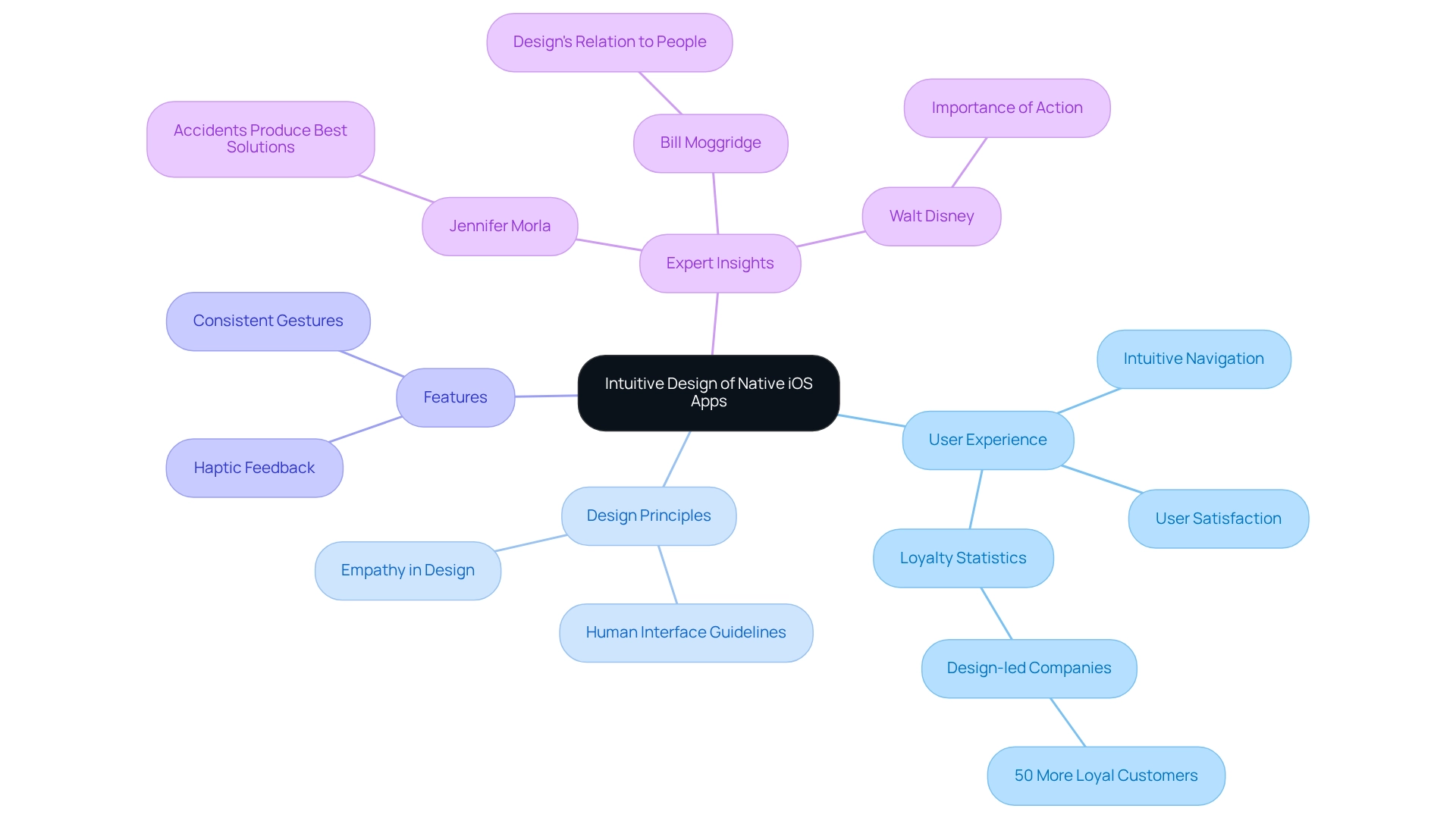
Direct Access to Device Features: Unlocking Hardware Capabilities with Native iOS Apps
Developers often face significant coding challenges that can hinder their productivity. Native iOS apps provide a powerful solution with their direct access to device hardware features like the camera, GPS, and accelerometer. This capability allows creators to build highly functional tools that enhance user engagement. For instance, real-time GPS data facilitates precise location tracking, enabling features such as geofencing and location-based services. Furthermore, the incorporation of ARKit empowers developers to design immersive augmented reality experiences, providing innovative interactions that web or hybrid solutions cannot match.
As mobile payments surged by 40% in Africa through app utilization, the importance of harnessing device features becomes increasingly evident. This trend underscores the necessity for creators to leverage hardware capabilities to develop engaging, user-focused software that stands out in a competitive market. In addition, with smartphones accounting for 55 percent of all website views in 2021, the significance of mobile applications in the digital landscape is undeniable. Kodezi's tools, including the Kodezi CLI, facilitate seamless code translation and auto-healing of codebases, further illustrating how native iOS apps can significantly enhance developer workflows and productivity. Imagine the efficiency gains you could achieve by utilizing these features.
As Kelly C Powell, Marketing Head & Engagement Manager, states, 'We collect your requirements, we offer a solution, we succeed together!' This emphasizes the collaborative effort in utilizing hardware features to enhance application functionality and user experience. Explore the tools available on the Kodezi platform to elevate your coding practices today.
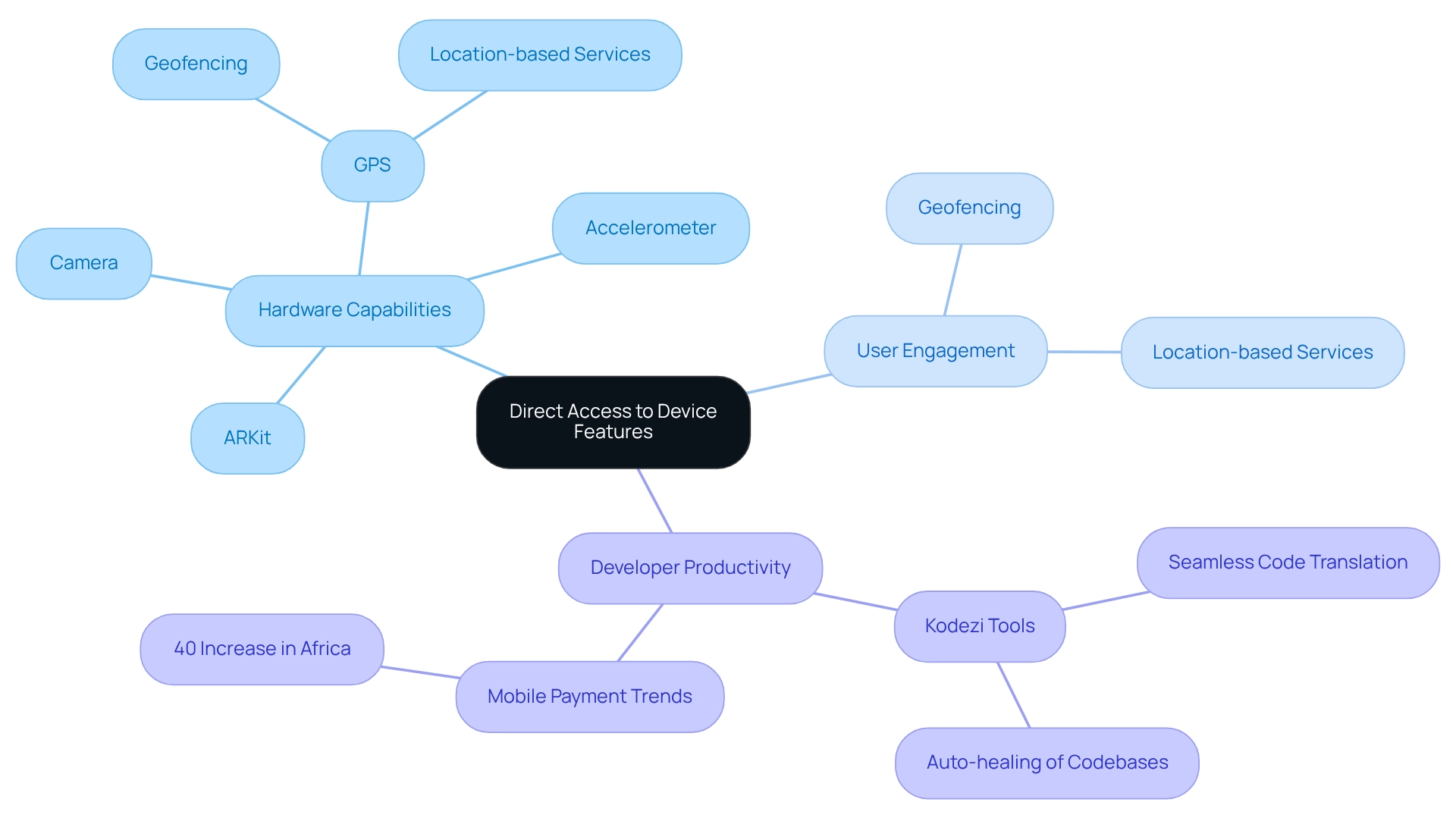
Robust Security: Protecting User Data with Native iOS Applications
Native iOS software leverages Apple's stringent security protocols, which incorporate data encryption, secure authentication, and regular software updates. Continuous software updates are essential to address security vulnerabilities and effectively protect sensitive data. These applications can utilize the Keychain for the secure storage of sensitive information, safeguarding data from unauthorized access. Furthermore, native apps can implement biometric authentication methods, such as Face ID and Touch ID, providing an additional layer of security. By adhering to best practices in security, software developers not only enhance the safety of personal and financial information but also cultivate trust with users.
In 2025, the emphasis on security is paramount, as data breaches in mobile software are on the rise, underscoring the necessity for robust security measures. Recent updates to security protocols for native iOS software reflect this urgency, ensuring developers are equipped to protect client data effectively. Data encryption plays a crucial role in ensuring that intercepted data remains unreadable and secure, highlighting the importance of this measure. Expert opinions, such as those from Build38, stress that mobile app security is no longer an optional consideration; it is a critical necessity. Case studies, such as the implementation of App Protector, illustrate how security technologies can identify and neutralize threats in real-time, further reinforcing the advantages of native iOS apps for maintaining data integrity. Additionally, Build38 provides APIs for attestation and response to security threats, which are essential tools for enhancing security in native iOS apps.
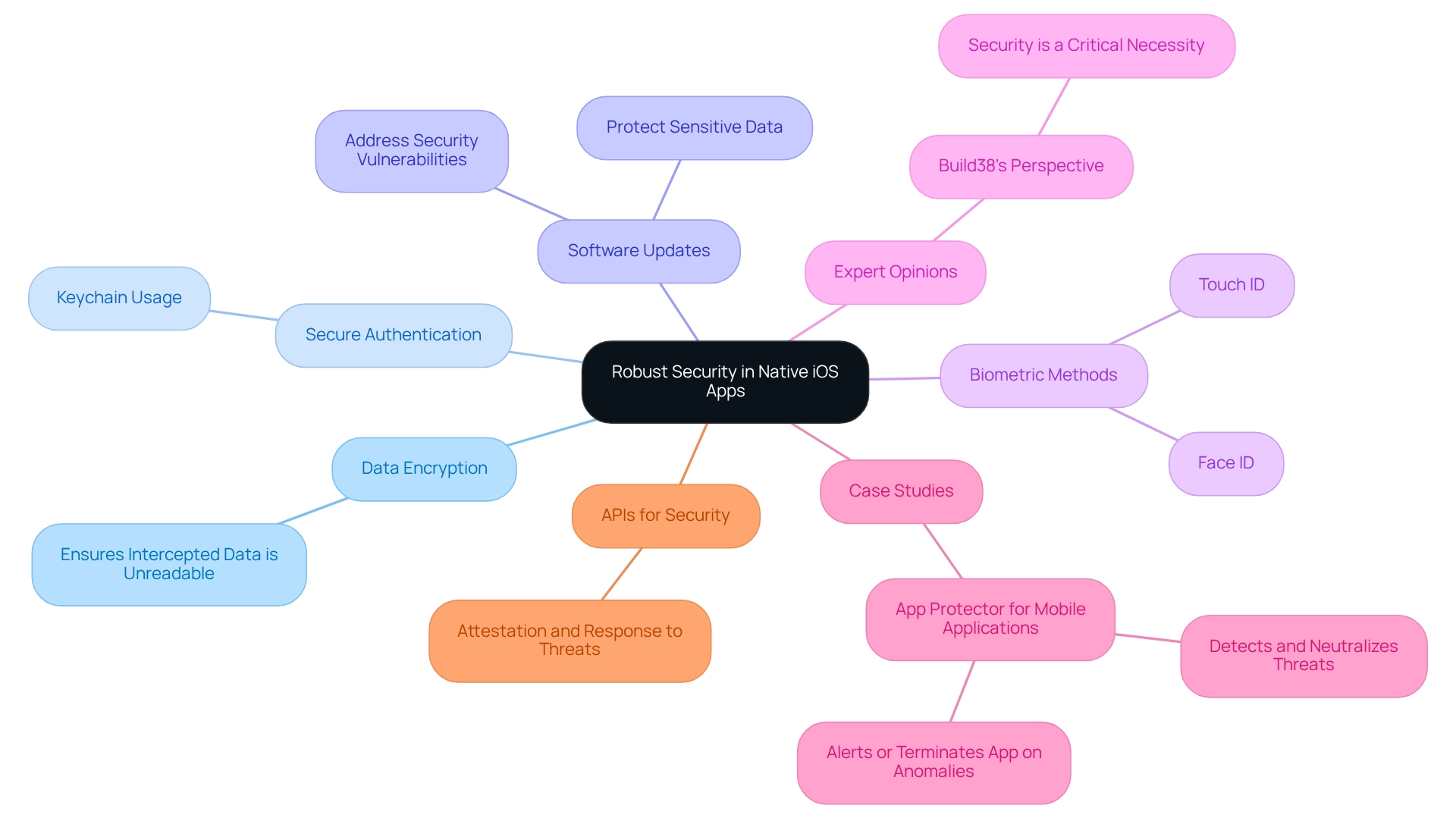
Compliance with App Store Guidelines: Ensuring Smooth App Approval for Native iOS Apps
Compliance with Apple's App Store guidelines is vital for the successful approval of native iOS apps. These guidelines cover essential elements such as privacy, security, and interface design. Are you aware that following these standards can significantly reduce the likelihood of rejection during the review process? For instance, adhering to user data handling protocols and providing transparent privacy policies can greatly enhance your chances of approval.
Statistics reveal that less than 1% of appeals to Apple's App Review Board succeed, underscoring the importance of getting it right the first time. Developers should stay updated on the latest guidelines, as third-party app stores may impose their own requirements, necessitating a thorough review of all applicable standards.
Successful collaborations in mobile app development often hinge on clear contractual agreements that define roles and responsibilities, which can further support a smooth submission process. Furthermore, utilizing resources like Apple Developer Documentation, App Store Connect, and CI/CD tools can simplify the app submission process.
By prioritizing compliance, creators can navigate the complexities of app approval more effectively, ultimately leading to greater success in the competitive app marketplace.
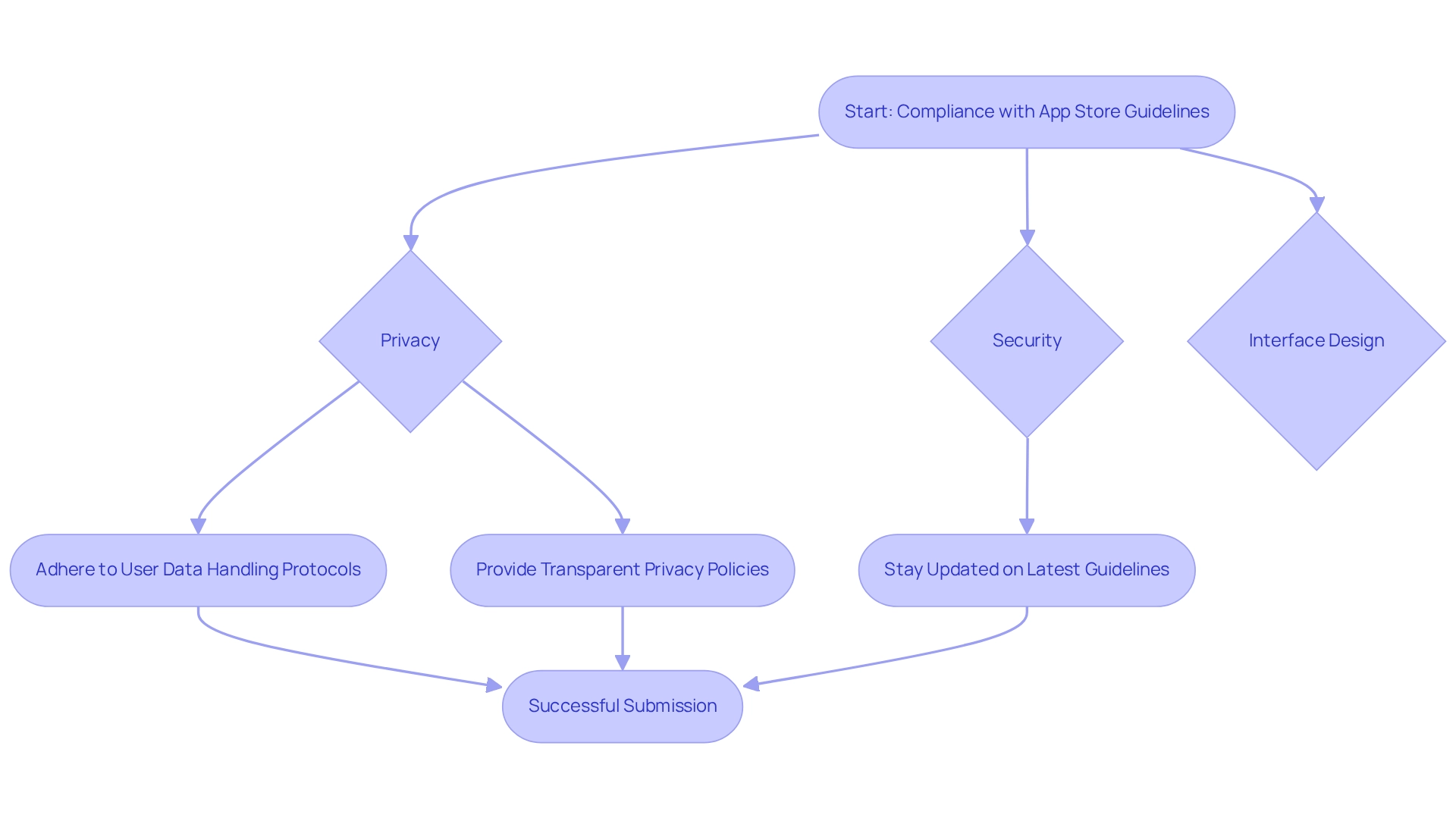
Long-Term Support: Continuous Updates and Improvements for Native iOS Apps
Developers often encounter significant coding challenges that can hinder their productivity and efficiency. Native iOS apps heavily rely on the ongoing support and updates provided by Apple, which ensures seamless compatibility with the latest iOS versions and features. This long-term support empowers developers to integrate new functionalities and enhance app performance over time. Frequent updates not only improve user experience but also address security vulnerabilities, thereby protecting data and preserving user trust. In fact, daily app usage has surged by 50% in some regions since 2020, underscoring the importance of keeping applications relevant and engaging.
How can developers effectively tackle these challenges? Enter Kodezi, a versatile tool designed to boost programmer productivity and streamline the debugging experience within IDEs. With features such as the Kodezi CLI, which automatically heals codebases, Kodezi simplifies debugging and enhances code quality. More than 1,000,000 individuals have praised its capacity to improve their coding practices. As one user noted, 'Kodezi has assisted me in discovering and correcting bugs more swiftly and conveniently than attempting to do so manually.' This highlights the critical role that regular updates play in the development lifecycle, ensuring that software not only meets current standards but also adapts to user needs.
What benefits can developers expect from utilizing Kodezi? Effective long-term support strategies, such as those provided by Kodezi, have been shown to improve the stability and performance of native iOS apps. By prioritizing regular updates as part of their development process, creators can ensure their apps remain competitive in a fast-paced technological landscape. Kodezi enables developers to uphold well-documented and secure code, ultimately leading to enhanced productivity and higher-quality applications. Explore the tools available on the Kodezi platform to elevate your coding experience and stay ahead in the ever-evolving tech environment.
Access to Skilled Developers: Finding Talent for Native iOS App Development
Locating proficient programmers for native iOS apps development is essential for overcoming the coding challenges that developers often face. Many programmers specialize in Swift and Objective-C, the primary languages for iOS development. To find qualified candidates, companies can utilize various platforms, including:
- Upwork
- Specialized tech job boards
Furthermore, attending tech meetups and conferences provides opportunities to connect with talented developers who are passionate about iOS development.
At Kodezi, we not only value technical skills but also seek candidates who resonate with our mission and vision. Our hiring process is designed to ensure a good fit and includes several steps:
- Applying for the position
- An introduction with the founders
- A technical interview
- A take-home task
- The offer stage
We encourage candidates to express their motivations for joining Kodezi and how they can contribute to solving the challenges we face.
Kodezi promotes a cooperative and creative environment. By assembling a team of talented individuals who share our principles, we can guarantee that our native iOS apps are developed efficiently and effectively, meeting our expectations. Are you ready to explore the tools available on our platform that can enhance your coding experience?
Seamless Integration: Connecting Native iOS Apps with Apple Services
Native iOS applications offer robust integration with essential Apple services, such as iCloud, Apple Pay, and Siri, which significantly enhances app functionality and user experience. Have you ever considered how Apple Pay facilitates secure and seamless payment processing? This feature is crucial for customer retention and satisfaction. Current adoption rates for Apple Pay in mobile applications are on the rise, with recent statistics indicating that over 70% of individuals prefer apps that offer Apple Pay, underscoring its growing importance in the app ecosystem.
Furthermore, iCloud integration allows for seamless data synchronization across devices, ensuring individuals can access their information anytime, anywhere. This capability not only boosts user engagement but also fosters a more cohesive experience, making applications more appealing in a competitive landscape.
Successful examples of these integrations are evident in various applications. For instance, a recent case study highlighted how HyperBeard, a hyper-casual mobile game studio, collaborated with Tenjin to refine their acquisition strategies. By utilizing Apple Pay to streamline transactions, they achieved a notable increase in conversion rates. Similarly, apps that leverage iCloud for data management report enhanced customer satisfaction due to the convenience of accessing their data across multiple devices.
Expert insights emphasize the importance of integrating Apple services into native iOS apps. Christopher Farm, CEO and Co-founder, asserts, 'Integrating native iOS apps along with Apple services not only enhances functionality but also provides a competitive edge in the market.' As the mobile app development landscape evolves, the strategic incorporation of Apple services is a pivotal factor in driving app success. Moreover, optimizing time to profitability (TTP) is essential for understanding audience growth and recouping investments in app development, further emphasizing the importance of these integrations.
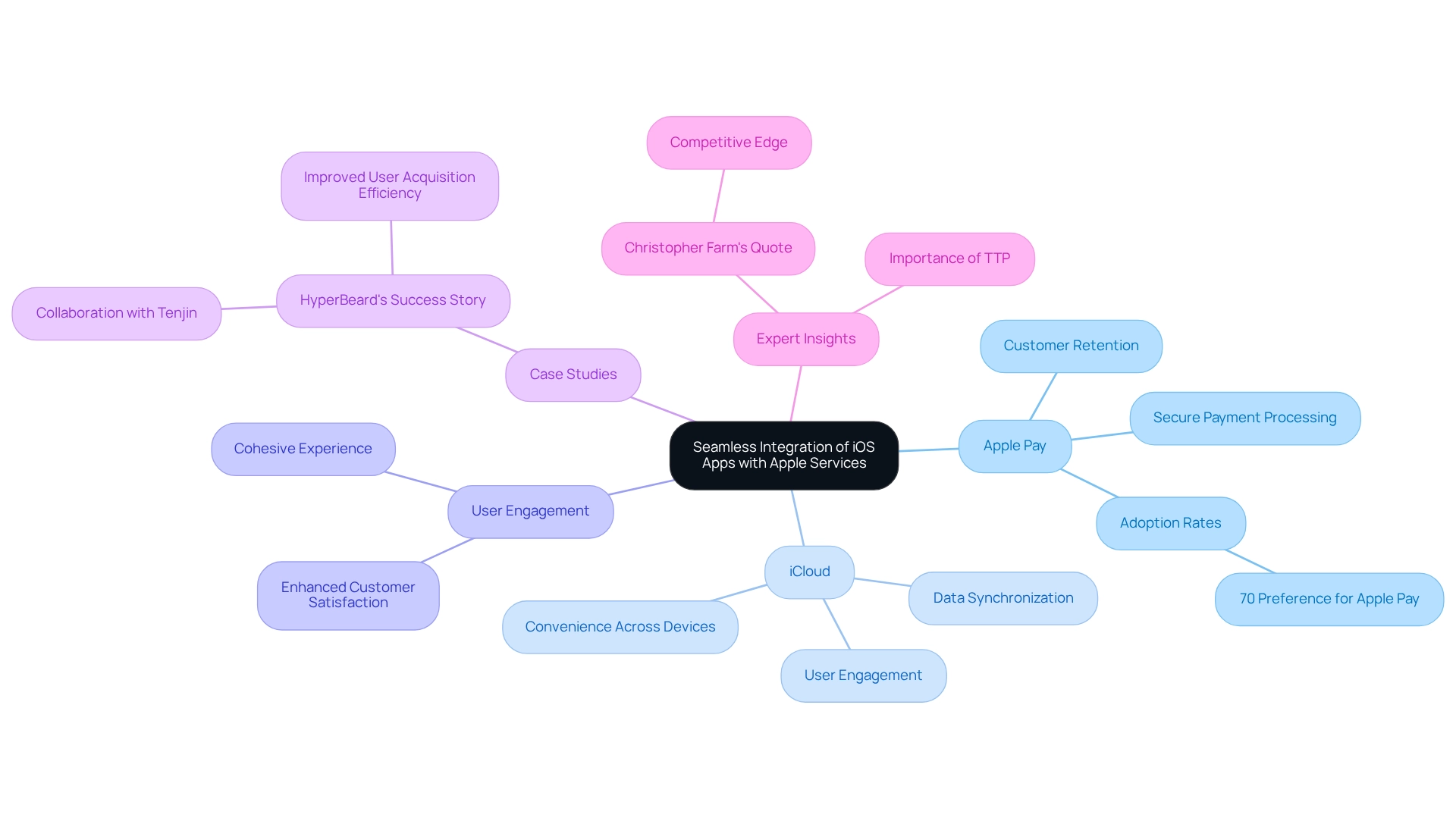
Monetization Opportunities: Maximizing Revenue with Native iOS Applications
Native iOS apps present a wealth of monetization opportunities, including in-app purchases, subscriptions, and advertising. The freemium model is particularly effective, enabling individuals to access essential features at no cost while providing premium functionalities for a fee. This method not only draws a wider audience but also promotes expenditure on extra features. For instance, the 572 interactions recorded on Level Up Coding highlight a strong interest in monetization strategies, showcasing the effectiveness of the freemium model in engaging users.
Furthermore, integrating advertisements can create a consistent revenue stream, especially for free applications. Recent trends indicate that creators are increasingly concentrating on subscription models, which have demonstrated the ability to significantly boost earnings. In 2025, the evolution of in-app purchases and subscriptions is marked by a growing reliance on artificial intelligence and localized content, as noted in the case study "Future Trends in App Monetization." This trend allows creators to customize their offerings for particular demographics and regions, maximizing their monetization potential.
To implement in-app purchases and subscriptions effectively, developers must understand consumer preferences and behaviors. As John Johnson wisely stated, "First, solve the problem. Then write the code." This insight is crucial for selecting the right monetization strategy that aligns with the app's objectives and target audience. In addition, integrating promotional calls to action, like motivating individuals to try free trials or demos, can greatly improve engagement and spending. Successful examples of in-app purchase models in native iOS apps demonstrate that providing tangible value to users can positively influence their spending patterns, ultimately maximizing revenue while ensuring a satisfying user experience.

Conclusion
The advantages of native iOS app development are not just clear; they are compelling. Developers face numerous coding challenges, but by harnessing the unique capabilities of Apple's ecosystem, they can create applications that perform exceptionally and offer a superior user experience. Tools like Kodezi address these challenges by streamlining documentation and enhancing productivity. This allows developers to focus on innovation rather than administrative tasks.
Furthermore, native iOS apps excel in performance optimization and robust security measures, outshining cross-platform alternatives. The seamless integration with hardware features and Apple services enhances functionality, ensuring users enjoy a cohesive and engaging experience. As the demand for high-quality applications continues to rise, adhering to Apple's guidelines becomes increasingly vital for successful app launches.
In addition, a strategic focus on native development not only meets user expectations but also positions developers for long-term success in a competitive landscape. By leveraging the strengths of native technologies and tools like Kodezi, developers can navigate challenges effectively, foster user loyalty, and unlock new monetization opportunities. The future of mobile app development lies in embracing these advantages and committing to excellence in every aspect of the development process.
Frequently Asked Questions
What challenges do programmers face in software development regarding documentation and code quality?
Programmers often struggle with managing documentation and ensuring code quality, which can hinder productivity and lead to errors.
How does Kodezi assist programmers in managing documentation?
Kodezi automates the generation of OpenAPI specifications, allowing programmers to quickly create professional-standard documentation for their APIs, which enhances productivity and reduces errors from manual processes.
What are the benefits of using Kodezi for developers?
Kodezi enables developers to spend more time coding rather than documenting, leading to faster development cycles and higher-quality applications. It also keeps API documentation in sync with code changes and includes features like AutoHeal for resolving codebase issues.
How does Kodezi simplify the documentation process?
Kodezi automatically generates Swagger sites from the codebase, making it easier for programmers to manage their APIs effectively.
What recent trends highlight the importance of OpenAPI specifications in native iOS app development?
There has been a notable increase in the adoption of OpenAPI specifications, which are crucial for optimizing workflows in native iOS app development.
Can you provide an example of a company that benefited from improved documentation practices?
M1 Finance raised $150 million, demonstrating the industry's commitment to enhancing development practices and the importance of comprehensive documentation for maintaining clarity and consistency.
What advantages do native iOS apps have over cross-platform alternatives?
Native iOS apps are optimized for Apple’s hardware and software, resulting in faster load times, smoother animations, and superior responsiveness, with performance enhancements reported up to 50% in engagement metrics.
What are some recent advancements that enhance native iOS app performance?
Advancements such as SwiftUI’s support for macOS Catalyst and improved gesture handling allow developers to create richer, more interactive experiences that leverage the iOS architecture for better performance.
How does adherence to Apple's Human Interface Guidelines impact user experience in native iOS apps?
It promotes intuitive navigation, familiar gestures, and a cohesive aesthetic, significantly enhancing user satisfaction and engagement.
Why is thoughtful design important for user retention in native iOS apps?
Design-led companies that prioritize user experience report 50% more loyal customers, highlighting the critical role of effective UX design in retaining users.




